
Unit 5, Silveroaks Farm, Hawkhurst Lane, Waldron, Heathfield, E.Sussex, UK, TN21 0RS
Tel (0)1435- 813393, International +44 1435 813393
VAT Reg. No. GB 241 7291 72

Unit 5, Silveroaks Farm, Hawkhurst
Lane,
Waldron, Heathfield, E.Sussex, UK, TN21 0RS
Tel (0)1435- 813393, International +44 1435 813393
VAT Reg. No. GB 241 7291 72
Pink Floyd – Relics
Originally published in Guitarist Magazine July 1995 written by Jordan
McLaughlin
There are few British superstar Musicians since the early 70’s who have not had reason to call on the services of Pete Cornish, Queen, Genesis, The Police, Black Sabbath, Iron Maiden, The Pretenders, Eric Clapton, Sting and even some non UK residents Bryan Adams and Lou Reed have turned to the amplification and effects guru when they have had need of a fully custom tailored, hand built system to get their guitar or bass sound together.
One of Pete’s longest standing professional relationships is with Pink Floyd – he has been closely involved in putting together rigs for several of the band’s musicians, including Mr. Gilmour of course, off and on for nearly 20 years and here he takes us through the major projects undertaken to ensure that works like Shine On You Crazy Diamond and Money sound as good from the 30th row as they do in your front room…
“March 7th 1976 was when the very first drawings were done for the first board I built for Dave – that included a Fuzz Face, a Cornish Custom Fuzz, MXR Phaser, a Uni-Vibe, a CryBaby, MXR Dynacomp and an MXR noise gate.”
“The routing starts with an input selector for two guitars, then onto a strobo tuner feed, then a master bypass before we get to the effects. First of all there’s a tone control – the board had three modified CryBabys on it – one of them is a tone control and one is a volume control, only one was actually a wah. The next thing is the Fuzz Face – Dave really liked the Dallas Arbiter Fuzz Face a lot – then my fuzz, then the MXR Phase 100, the Uni-Vibe, then the wah with a reverse switch on it to reverse the travel, the MXR Dynacomp, then a send and return, the MXR noise gate and then three outputs, each with their own on/off switch, so Dave could have any combination of the three amps (HiWatt, Marshall or Yamaha) on at any one time.”
“In 1977 we moved the tone circuit to just before the volume pedal, and we added a treble and bass boost, which I think was a Colorsound unit – that went between the Uni-Vibe and the wah.”
“The drawings for the second board are dated 15/2/79 – my birthday! It’s got the same input selector as the first board, master bypass, MXR Dynacomp, Fuzz Face, Big Muff, send and return for each echo, MXR Phase 100, a Deluxe Electric Mistress flanger which has been modded, the Colorsound treble and bass boost, a volume pedal and a ‘Vib’ pedal, which is known as the Money pedal. Something I’m asked to do quite a lot is reproduce sounds from records which can be difficult, but it has its advantages – I’m nearly always given the artist’s whole back catalogue to work from!”
“This board’s got just one CryBaby, fitted out as a volume pedal – by this time we’d standardized the CryBaby body for pedal controllers, they looked good, they were very well built and sturdy and Phil liked them! And then up to about Oct ’82 I did certain other mods – the Fuzz Face had a tone circuit fitted, I fitted a Boss CE-2 and actually we moved the compressor to a parallel circuit with the treble and bass boost.”
“For ‘The Wall’ Dave had his main board, the one with the three CryBabys on and I made another one for Snowy White for all the acoustic guitars. They sat behind the wall but during the show the musicians moved to the front of the stage, in front of the wall that had been built. Obviously they couldn’t pick up all that stuff and move it so I made four small pedal boards – two bass and two guitar – because each member of the band was shadowed by another person, dressed in grey, I think. I made the boards as mirror images of each other, so in a pair one would have all the leads to the right, like Dave’s and Snowy’s would have all the connections to the left, so they could stand next to each other and play.”
“These little boards have a single input, a Big Muff, one send and return, the Electric Mistress flanger, a volume pedal and a master bypass, all coming out of two outputs, which went into the HiWatt amps.”